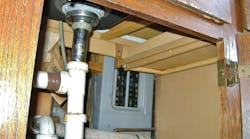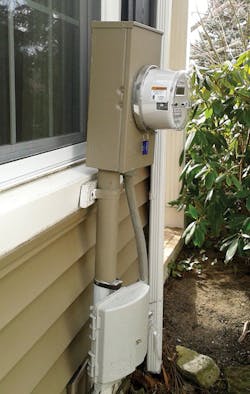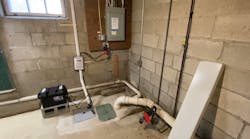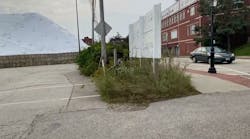All references are based on the 2014 edition of the NEC.
Frame Job
Perhaps the installer thought this would go unnoticed. Section 110.13(A) requires electrical equipment to be “firmly secured to the surface on which it is mounted.” In this case, the meter enclosure is mounted to nothing but air. How are we supposed to secure an enclosure to air? I certainly wouldn’t consider this “neat and workmanlike” either, as required by Sec. 110.12. The communication equipment and wiring that is attached to the raceway is another problem. According to Sec. 800.133(B), “communications wires and cables shall not be strapped, taped, or attached by any means to the exterior of any raceway as a means of support.” The unsupported service cable leaving the meter enclosure needs to be secured within 12 in. of the enclosure in accordance with Sec. 230.51(A).
Hide and Seek
Now where could that panelboard be hiding? Oh, under the kitchen sink of course!
This hidden surprise was sent in by George Parrish, an electrical inspector for the City of Hagerstown, Md. “Russ, I thought I’d share a photo I took while conducting an inspection,” says Hagerstown. “The previous owner converted a storage room to a kitchen. Enjoy!”
How in the world are we supposed to gain access to this panelboard and the breakers? This is a blatant violation of Sec. 240.24(A), which requires overcurrent devices to be readily accessible. The lack of any headroom and safe working space also violates Sec. 110.26(A). And the plumbing pipes directly below the panelboard create a violation of the dedicated space requirements found in Sec. 110.26(E).
The cover of the panelboard was probably torn off in an attempt to make the breakers somewhat accessible. But this missing cover now violates the intent of Sec. 110.12(B) because the mechanical integrity of the enclosure has been compromised. It also increases the chance of physical damage to the circuit breakers. Section 240.24(C) requires overcurrent devices to be located where they will not be exposed to physical damage.






